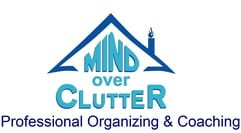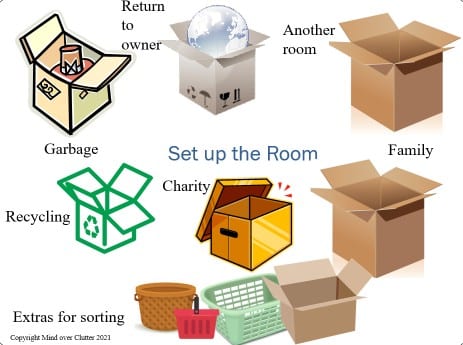These are the steps, decluttering then organizing
Just because something brought you joy in the past doesn’t mean you should carry it forever. The possessions you keep should represent the person you are trying to become, not the person you were. Keep this in mind when you start your decluttering journey. As you start to let go of things it will become easier and easier. Here are steps to help you on your path to finding your treasures.
Planning the space
1. Decide what the goal is for the room. Is it to have a:
- Beautiful compact space
- Functional workshop
- Sense of freedom and control
- the Joy of financially exchanging stuff for new experiences and pleasures.
- Clear out a parent’s home
- Make things easier for the next generation
- Streamline your lifestyle
2. Decide what you want the room to look like and be used for. Draw a floor plan and make a list of activities that happen in that space. It will help you to know what to keep.
3. Decision criteria
Set up some questions to help you with your decision making. Here are some examples:
- How many of these do I have? How many is enough?
- Does the item fit in with my values?
- Is this item current?
- Is this item really valuable?
- Will owning this help to resolve my clutter?
- What is the worst thing that can happen if I don’t have it?
- Can I borrow it from somewhere?
- Does it bring me joy?
- Do you need it?
4. How much is enough?
Look around the room and decide what percentage of stuff you need to give away so everything will fit into the room. 25% 50% 75%?
5. If you don’t schedule it, it won’t get done.
Schedule time and do it when you are not rushed. Do one area, room, box or even corner of a room depending on how much stuff you have to go through and your deadline.
6. Prepare the room for working.
You will need a series of boxes, bins, bags or containers. for garbage, recycling, donations, items to go to other rooms, and items to return to people.
5 Methods for decluttering the room
I’m going to go through a number of ways to sort through your items and you can decide what method works best for you. At first, decluttering is easy because you find items that you know you don’t want and just haven’t given them away yet. Then it becomes more challenging. You must chip away at identifying which items are true treasures versus those you feel guilty about giving away. Remember to reduce by the percentage you choose in your planning.
1. Have a box
The simplest way to start is to keep a box in your closet and whenever you find something you don’t need put it into the box and you can start decluttering right away.
2. Skimming
- Go to a closet/cupboard and select the best items in each category.
- Most cupboards/closets will have more than one category.
- For example, in a kitchen, the cupboard might have baking dishes, casserole dishes, muffin tins, and loaf pans. Pick the best 1 or 2 of each of these 4 categories and donate the rest.
- Continue to open each cupboard and drawer skimming the contents and selecting 1 or 2 items from each category.
3. Sort then declutter
- Go clockwise around the room sorting items into groups by function
- Do the surfaces first and then the drawers and cupboards next
- When you are done, the garbage and recycling will be collected and removed from the room
- All the items in the room will be in groups
- Each room will have different categories/groups of items. Here are some examples, books, electronics, tools, dishes, home decor, games, clothing, photos etc
Look at one category/group and apply the questions and percentage you determined in the planning stage. Start removing items.
If that method doesn’t work for you and you are keeping everything, try a different method.
4. Grouping
Keep the Best of the Best. Instead of thinking about giving things away, it might be easier to think about keeping the best.
- After you have sorted the room make sure you are keeping the best one. You need to see all of the items in one group together and keep only as many as you need or the percentage you set in the planning stage, keep the best ones.
5. Triage
- Gather all your items from one category
- Pick up the first three and remove the one you like the least.
- Pick up 3 more and remove one again
- After you have gone through the category/group you will have decluttered by 1/3
If you are sentimental
- Try taking a picture of the items so you have the memory and let go of the item go.
- Find a good home for the thing you are letting go of, they are still useful just not to you anymore.
- “Shrink it”, only keep one item from a collection instead of the entire collection, you will still have the memory
- Ask yourself, what would be best, having a number of boxes with large quantities of unsorted keepsakes or a carefully assembled box of very precious treasures?
Decluttering is about having a mindset of letting go and having less. Once you experience the joy of being unburdened from cleaning, organizing, buying, and repairing stuff you don’t need, want, use or like you’ll wonder why you didn’t start sooner. Enjoy the journey. Set your goals, develop your decision criteria and then begin decluttering your space. Share on X
Did I miss anything?
If you need help to start your decluttering project work with me virtually on zoom.
 Julie Stobbe is a Trained Professional Organizer and Lifestyle Organizing Coach who brings happiness to homes and organization to offices, coaching you virtually using Zoom. She has been working with clients since 2006 to provide customized organizing solutions to suit their individual needs and situations. She uses her love of teaching to reduce clutter, in your home, office, mind and time. She guides and supports you to be accountable for your time, to complete projects and to reach your goals. If you’re in a difficult transition Julie can coach you to break-free of emotional clutter constraining you from living life on your terms. Online courses are available to help instruct, coach and support your organizing projects. Get started by downloading Tips for Reorganizing 9 Rooms.
Julie Stobbe is a Trained Professional Organizer and Lifestyle Organizing Coach who brings happiness to homes and organization to offices, coaching you virtually using Zoom. She has been working with clients since 2006 to provide customized organizing solutions to suit their individual needs and situations. She uses her love of teaching to reduce clutter, in your home, office, mind and time. She guides and supports you to be accountable for your time, to complete projects and to reach your goals. If you’re in a difficult transition Julie can coach you to break-free of emotional clutter constraining you from living life on your terms. Online courses are available to help instruct, coach and support your organizing projects. Get started by downloading Tips for Reorganizing 9 Rooms.
Contact her at julie@mindoverclutter.ca
X – Facebook – Facebook group Organizing Mind and Space



These are all fundamental, helpful decluttering principles. I love that last point about dealing with sentimental items so much. When we keep too much, we tend to look at none of it. When we keep a reasonable amount, such as one box of treasures, we tend to pull it out and look enjoy it. Keep what you can and will enjoy!
I see too many people keeping things and not enjoying them. I encourage them to use their stuff because the person they are saving it for may not want it.
I love these steps! I am a sentimental person, so I do find that taking pictures allows me to get rid of the stuff without guilt. Thanks for sharing this great content.
Thanks for your comment. Making decluttering a series of steps I hope will make it easy for everyone to let go of what they don’t need.
I like how you set this up by establishing some boundaries and clarifying why FIRST before beginning the physical act of decluttering and organizing. It’s not uncommon to want to jump right in. But taking some time upfront to THINK will make the process go more smoothly. There will be some bumps, but not as many.
The act of space mapping is so often overlooked. Projects that I’m working on always turn out the best and most consistent if I physically design, on paper, what I want everything to look like. Thanks for taking us through the process!
I agree, everyone wants to get started on the space and don’t like to spend time on the planning.
Deciding how you want to use the room to be decluttered is super helpful in helping someone decide what to keep and what to donate!
I think it is especially helpful for people that find it hard to make decisions. They only have to decide if it stays in the room or leaves the room. Later they can decide if they want to keep it. Using 2 steps might make it easier to get the room decluttered.
I love the way you combined classic and some novel approaches to reducing the excess. So often, we naturally focus on “should I get rid of this” but skimming and triage are great ways to reduce the clutter from a position of abundance, which will reduce fear of letting things go. I really like your approach!
Thanks for your comments. I really try to give clients a number of options so they can find a way that works well for them. Sometimes it is a mindset, what will I keep, sometimes it is a technique.